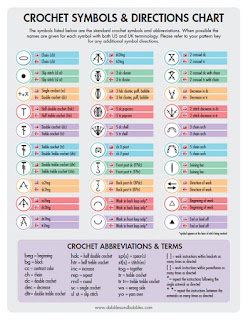I found this article to be very interesting (from HERE). Nice to know where this craft that I love came from.
Crochet History
The birth date of crochet has been a controversial issue for years with the question, "When did crochet history begin? According to me, I define true "crochet" as working series of stitches using a hook to create a doily, motif, or garment. Many try to attribute the use of a hook to make a single stitch as being "crochet". I disagree. No one is quite sure when and where crochet got its start, probably sometime before 1880.
Tambour Gives Birth to Crochet
Research suggests that crochet probably developed most directly from Chinese needlework, a very ancient form of embroidery known in Turkey, India, Persia and North Africa, which reached Europe in the 1700s and was referred to as "tambouring," from the French "tambour" or drum.
In this technique, a background fabric is stretched taut on a frame. The working thread is held underneath the fabric. A needle with a hook is inserted downward and a loop of the working thread drawn up through the fabric. With the loop still on the hook, the hook is then inserted a little farther along and another loop of the working thread is drawn up and worked through the first loop to form a chain stitch. The tambour hooks were as thin as sewing needles, so the work must have been accomplished with very fine thread.
At the end of the 18th century, tambour evolved into what the French called "crochet in the air," when the background fabric was discarded and the stitch worked on its own.
Crochet in the 19th Century
Crochet began turning up in Europe in the early 1800s and was given a tremendous boost by Mlle. Riego de la Branchardiere, who was best known for her ability to take old-style needle and bobbin lace designs and turn them into crochet patterns that could easily be duplicated. She published many pattern books so that millions of women could begin to copy her designs. Mlle. Riego also claimed to have invented "lace-like" crochet, today called Irish crochet.
Lavish crochet emerged along with other elaborate needlework of the 1800’s. Proceeds from crochet items saved the Irish from starvation in the late 1800’s.
A Craft for the Rich
At one time crochet was considered for the wealthy only, for lavish decor in the home and dress. The poor folk were expected to stick with knitting basic needs such as socks and clothing and not dally around with experimental crochet. Angry words were published in magazines from the wealthy stating the lower class should stick to making necessities rather than fancy items that was not their place to wear or display. The poor to middle class lashed back as to their rights to use crochet as they pleased. Can you imagine today, someone telling us we should not use a particular craft because of our financial background? Much of this idea stemmed from fear the servants would be spending time crocheting when they should be working at the employer’s home. Because crochet samples can not be found among the many needlework methods taught in schools of the past, it is surmised crochet was left out because of the danger of experimentation and foolery.
Bead Crochet Debuts
In the 1800’s, bead crocheted bags, clothing and decor were a hit. Bead crochet bag popularity continued through the 1950’s. Fashion trends included bead and thread crochet through the 1970’s but not like the heydays of the 1800’s. The 1980’s through the 1990’s began a renaissance for bead and thread crochet.
Today we are entering new millennium with bead crochet becoming ever more popular and combined with many other bead and fiber techniques; using old techniques to create new art.
Knitting with beads was already in fashion when bead crocheted began to appear on the market in the 1830’s. Bead Knitted bag patterns for scenics and other elaborate patterns required planning exact bead stringing. Bead crochet bags could be made without extensive planning and included more freeform techniques. Bead knitted and crocheted items continued in popularity through the early 1900’s. The Roaring ‘20’s brought in a new flood of bead crocheted bags with piles of bead loops hanging all over to go along with flapper attire. Then in the 1980’s bead crochet along with bead knitting had a resurgence along with fiber knitting and crochet. In the early 1990’s bead knitted bags gained popularity which in turn brought excitement to bead crocheted bags.
Today vintage thread crochet samplers of the 1800’s are available for study in various museums. Piecework Magazine continues to be an excellent resource for needlework sampler history including bead and thread crochet.
Resources for Historical Information:
Material for this article came from excellent sources;
"A Living Mystery, the International Art & History of Crochet," Annie Louise Potter,
A.J. Publishing International, 1990; and
"Crochet History & Technique,"
Lis Paludan, Interweave Press, 1995.
September 1997, issue of The Chain Link Newsletter
Crochet Guild Of America www.crochet.com
website source: Janet's treasures
Dooner,Kate, A Century of Handbags, Schiffer Publishing, Ltd, Atglen, PA, 1993
Ettinger, Roseann, Handbags, Schiffer Publishing, Ltd, West Chester, PA, 1991
Haertig, Evelyn, More Beautiful Purse, Gallery Graphics Press, Carmel, CA, 1990
Haertig, Evelyn, Restoring and Collecting Antique Beaded Purses by, Gallery Graphics Press, Carmel, CA, 2000
Holiner, Richard, Antique Purses, A History, Identification and Value Guide, Second Edition, Collector Books, Paducah, KY, 1987
Potter, Annie Louise, A Living Mystery, The International Art & History of Crochet, 1990, A.J. Publishing International, USA, ISBN 1-879409-00-3
Paludan, Lis, Crochet, History & Technique, 1995, Interweave Press, Loveland, CO, ISBN 1-883010-09-8
Schwartz, Lynell K., Vintage Purses At Their Best, Schiffer Publishing, Ltd, Atglen, PA, 1995
website source:http://www.beadwrangler.com/samplers/crochet1/crochet_history.htm




